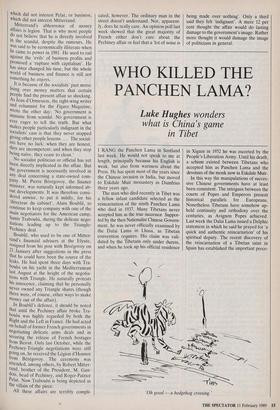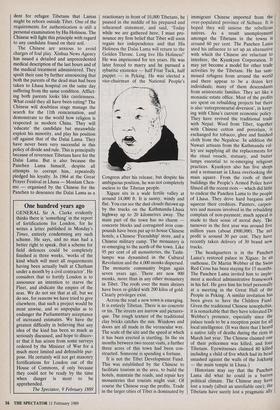WHO KILLED THE PANCHEN LAMA?
Luke Hughes wonders
what is China's game in Tibet
I RANG the Panchen Lama in Scotland last week. He would not speak to me at length, principally because his English is weak, but also from wariness about the Press. He has spent most of the years since the Chinese invasion in India, but moved to Eskdale Muir monastery in Dumfries three years ago.
The man who died recently in Tibet was a fellow infant candidate selected as the reincarnation of the ninth Panchen Lama who died in 1937. Many Tibetans never accepted him as the true successor. Suppor- ted by the then Nationalist Chinese Govern- ment, he was never officially examined by the Dalai Lama in Lhasa, as Tibetan convention requires. His claim was vali- dated by the Tibetans only under duress, and when he took up his official residence in Xigaze in 1952 he was escorted by the People's Liberation Army. Until his death, a schism existed between Tibetans who accepted him as Panchen Lama and the devotees of the monk now in Eskdale Muir.
In this way the manipulations of succes- sive Chinese governments have at least been consistent. The intrigues between the courts of Popes and Emperors present historical parallels for Europeans. Nonetheless Tibetans have somehow up- held continuity and orthodoxy over the centuries, as Avignon Popes achieved. Last week the Dalai Lama issued a Delphic statement in which he said he prayed for `a quick and authentic reincarnation' of his spiritual deputy. The recent discovery of the reincarnation of a Tibetan saint in Spain has established the important prece-
'Oh good — a hedgehog crossing.'
dent for refugee Tibetans that Lamas might be reborn outside Tibet. One of the requirements for authentication is still a personal examination by His Holiness. The Chinese will fight this principle with regard to any candidate found on their soil.
The Chinese are anxious to avoid charges of foul play. Xinhua News Agency has issued a detailed and unprecedented medical description of the last hours and of the medical treatment administered. They spoilt their case by further announcing that both the parents of the dead man had been taken to Lhasa hospital on the same day suffering from the same condition. Afflict- ing both parents looks like carelessness. What could they all have been eating? The Chinese will doubtless stage manage the search for the 11th reincarnation, and demonstrate to the world how religion is respected in modern China. They will `educate' the candidate but meanwhile exploit his minority, and play his position off against that of the Dalai Lama. They have never been very successful in this policy of divide and rule. This is principally because of reverence Tibetans have for the Dalai Lama. But is also because the Panchen Lama himself, despite all attempts to corrupt him, repeatedly pledged his loyalty. In 1964 at the Great Prayer Festival in Lhasa — Monlam Chen- mo — organised by the Chinese for the Panchen to denounce the Dalai Lama as a reactionary in front of 10,000 Tibetans, he paused in the middle of his prepared and rehearsed statement, and said, 'Today while we are gathered here, I must pro- nounce my firm belief that Tibet will soon regain her independence and that His Holiness the Dalai Lama will return to the Golden Throne. Long live His Holiness!' He was imprisoned for ten years. He was later forced to marry and he pursued a sybaritic existence — half Friar Tuck, half puppet — in Peking. He was elected a vice-chairman of the National People's Congress after his release, but despite his ambiguous position, he was not completely useless to the Tibetan people.
Xigaze sits in a wide fertile valley at around 14,000 ft. It is sunny, windy and flat. You can see the dust clouds thrown up by the trucks on the Kathmandu-Lhasa highway up to 20 kilometres away. The main part of the town has no charm concrete blocks and corrugated iron com- pounds have been put up to house Chinese hotels, a Chinese 'Friendship' store, and a Chinese military camp. The monastery is re-emerging to the north of the town. Like 95 per cent of all monasteries, the Tashi- lumpo was dynamited in the Cultural Revolution and the 4,000 monks dispersed. The monastic community began again seven years ago. There are now 900 monks, more than in any other monastery in Tibet. The roofs over the main shrines have been re-gilded with 200 kilos of gold. Clearly privileges exist.
Across the road a new town is emerging. It is entirely Tibetan. There is no concrete or tin. The streets are narrow and pictures- que. The rough texture of the traditional clay bricks catches the sun. Windows and doors are all made in the vernacular way. The scale of the site and the speed at which it has been erected is startling. In the six months between two recent visits, a further three acres of this town had been con- structed. Someone is spending a fortune.
It is not the Tibet Development Fund. This was established by the Chinese to facilitate tourism in the area, to build the hotels, maintain the roads, and repair key monasteries that tourists might visit. Of course the Chinese reap the profits. Trade in the larger cities of Tibet is dominated by immigrant Chinese imported from the over-populated province of Sichuan. It is hoped they will sinicise the rebellious natives. As a result unemployment amongst the Tibetans in the towns is around 60 per cent. The Panchen Lama used his influence to set up an alternative with which the Chinese are reluctant to interfere, the Kyankyen Corporation. It may yet become a model for other trade activities by the Tibetans. He has sum- moned refugees from around the world and there appear to be a dozen key individuals; many of them descendants from aristocratic families. They act like a monastic-estate office. Most of the profits are spent on rebuilding projects but there is also 'entrepreneurial diversion', in keep- ing with China's current economic policy. They have revived the traditional trade with Nepal-. Wool from Tibet, together with Chinese cotton and porcelain, is exchanged for tobacco, ghee and finished cloth from the Nepalese. In addition the Nawari artisans from the Kathmandu val- ley are supplying all the replacements for the ritual vessels, statuary, and butter lamps essential to re-emerging religious practices. Kyankyen also has five shops and a restaurant in Lhasa overlooking the main square. From the roofs of these buildings the People's Armed Police have filmed all the recent riots — which did little to endear the Panchen Lama to the people of Lhasa. They drive hard bargains and squeeze their creditors. Painters, carpen- ters and masons involved in the rebuilding complain of non-payment; much appeal is made to their sense of moral duty. The turnover in the first year was around five million yuan (about £900,000). The net profit is around 30 per cent. They have recently taken delivery of 30 brand new trucks.
The headquarters is in the Panchen Lama's restored palace in Xigaze. In all outhouse, Dr Martin Webber of the Swiss Red Cross has been staying for 15 months. The Panchen Lama invited him to imple- ment a medical administrative framework in his fief. He gave him his brief personally at a meeting in the Great Hall of the People in Peking. A similar invitation has been given to Save the Children Fund. Given the traditional Chinese xenophobia, it is remarkable that they have tolerated Dr Webber's presence, especially since the palace tends to be a reception point for all local intelligence. (It was there that I heard a native tally of deaths during the riots in March last year. The Chinese claimed one of their policemen was killed, and four Tibetans. Eyewitnesses claimed 80 killed including a child of five which had its head smashed against the walls of the Jokhang — the main temple in Lhasa.) Historians may say that the Panchen Lama did what he could in a barren political climate. The Chinese may have lost a toady (albeit an unreliable one); the Tibetans have surely lost a pragmatic ally in Peking; but the Dalai Lama himself must feel increasingly isolated. If he now happened to disappear, say, in an air crash (Lin Pao? Zia?) it would be 25 years before the Tibetans would have any effective leadership, a point which will have un- doubtedly occurred to the Chinese.
Luke Hughes has been a member of several recent mountaineering expeditions to Tibet.




























































 Previous page
Previous page